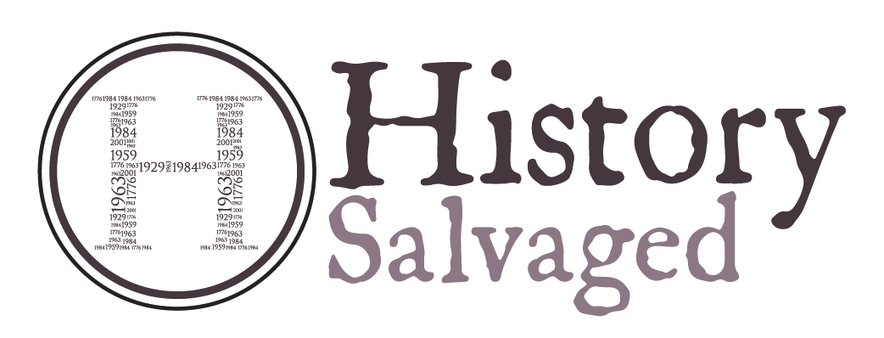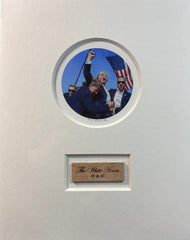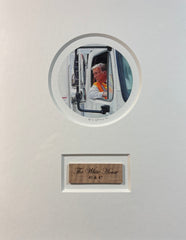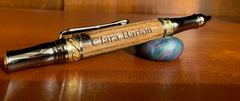Historic & cultural america
History Salvaged along with working with historic sites, museums and fraternal organizations continually search for new and exciting Witness Wood® and other materials of historic significance. Hereinbelow is a brief description of some very scarce Witness Woods® acquired by History Salvaged that is from Historic and Cultural Sites across America.
Due to the rarity of many these Witness Woods® and because almost ALL of our Witness Wood® pens are custom made to order, there may NOT be a listing for a specific pen or other items for certain woods listed in our store.
PLEASE EMAIL US - if there is a specific Witness Wood® pen or other items you are interested in!
Email Bob@HistorySalvaged.com and we will be happy to work with you to create your perfect custom pen, knife, cufflinks, or other items. Please note: History Salvaged custom handcrafted pens typically are delivered in 2 weeks for placement of your order.
_______________________________________
Sam Houston Pecan Tree
Sam Houston Pecan product is created from Witness Wood® acquired by History Salvaged, at auction, of a legendary tree in Texas lore from the house in Huntsville, TX that Sam Houston loved best and resided at for 20 years.
In the south corner of his spacious yard, only the stump remains of this native pecan, which grew into a beautiful tree of immense proportions. This magnificent tree died in 1974. According to Houston's granddaughter, Mrs. Jennie Morrow Decker of Houston, her grandfather planted the tree in 1847. While returning from a trip, he had need of a buggy whip to spur his lazy horse, having none, he stopped beside the road and pulled up a small pecan sapling, which served his purpose well. Arriving at his home, he saw that the roots were still intact, so he planted the sapling in the yard and it grew.
The Sam Houston Pecan produced a fruit, which was small but quite delicious. For many years, its pecans were distributed to Texas schools and colleges by Sam Houston State University at Huntsville. A number of the nuts also were sent to other state capitols and to the U.S. Capitol in Washington.
Grand Ole Opry Stage Floor
If the pieces of maple floorboards acquired by History Salvaged at auction and used to create our custom handcrafted pens could speak, they would proudly tell you of appearances by Presidents Jimmy Carter, Richard Nixon, Ronald Reagan, and George Bush. They would talk of visits from Princess Grace of Monaco; Ambassadors to the United Nations, the Apollo-Soyez crew and rock star Bruce Springsteen.
These pieces of maple Witness Wood® would speak of the familiar steps of country music immortals: Roy Acuff, Hank Snow, Ernest Tubb, Marty Robbins, Minnie Pearl, Ricky Skaggs, Barbara Mandrell, Reba McEntire, Loretta Lynn, Dolly Parton, and countless others.
From the "Opry" floor, a piece of which is now presented in our amazing little pens, giants stood and proudly sang the music America loves.
Packard Proving Grounds
The Packard Proving Ground pens are a part of a collection created from Witness Wood® acquired by History Salvaged that was removed and made available to HS by the Packard Motor Car Foundation.
The Packard Proving Ground Witness Wood® is old-growth oak paneling carefully removed during the restoration of the Historic Packard Factory. The oak has tight growth rings and a straight pattern and was 200-300 years old when it was cut and installed in the East Grand Boulevard factory complex more than 100 years ago in 1912 and a portion of the proceeds from our acquisition benefit the Packard Proving Ground Historic Site.
The Packard Proving Grounds was added to the National Register of Historic Places in 2000. The site is a part of the MotorCities National Heritage Area established in southeast Michigan by the National Park Service and restoration work at the Packard Proving Grounds Historic Site is being done to National Park Service standards for historic preservation
Henry Ford’s Fair Lane Mansion
History Salvaged Henry Ford - Fair Lane pens are created from Witness Wood® that was recently removed from Henry Ford’s Fair Lane Mansion Library during restoration. It is rare that any wood becomes available from a National Historic Site and our custom handcrafted pen made from one of the Fair Lane Library floorboards is not only an heirloom for a bygone time but another tribute to one of the great innovators, businessman, and giants of the 20th Century.
Our Henry Ford - Fair Lane product, commemorates Ford Motor Company founder, Henry Ford, his wife Clara Ford and their Dearborn, Michigan, estate: Fair Lane.
Fair Lane was named after an area in County Cork in Ireland where Ford's adoptive grandfather, Patrick Ahern, was born. The 1,300-acre estate along the River Rouge included a large limestone house, an electrical power plant on the dammed river, a greenhouse, a boathouse, riding stables, a children's playhouse, a treehouse and extensive landmark gardens designed by Chicago landscape architect Jens Jensen. The residence and part of the estate grounds are open to the public as a historical landscape and house museum and preserved as a National Historic Landmark.
Ghiradelli Square & Chocolate Factory
The oldest buildings in San Francisco's Ghirardelli Square were already standing in 1893 when Domingo Ghirardelli's sons purchased the entire block of property in San Francisco's Fisherman's Warf to use as the headquarters for their father's successful chocolate business.
From 1899 to 1915 the Ghirardelli family continued to add four more buildings: the Chocolate Factory, the Cocoa Building, the Clock Tower and the Power House. In the 1960s when the Ghirardelli Chocolate Company was sold, prominent San Franciscan, Mrs. William P. Roth, and her son bought the factory property and restored many of the original buildings to create the tourist attraction we know today. As Ghirardelli Square has undergone more changes in the past several years to make way for things like seismic upgrades, luxury timeshare apartments, and a wine tasting area, History Salvaged has been able to secure some wood from recently removed beams from this 1982 inductee to the National Register of Historic Places.
Warner Brothers Prop & Studio Building
History Salvaged has acquired a limited quantity of beautiful Douglas Fir from the 1936 Warner Brothers Prop and Studio Building. Founded in 1918, Warner Brothers is one of the world's largest producers of film and television entertainment. In 1904 the Brothers focused on film distribution but by World War I, they were producing films and in 1918 opened the Warner Bros. Studio on Sunset Blvd in Hollywood.
In April of 1923, with help from a loan, they formally incorporated Warner Brothers Pictures and 2008 Building 89 on the historic Warner Brothers lot was carefully deconstructed to make way for a new sound stage. Committed to recycling, Warner Brothers preserved some of the Douglas Fir timbers from that building. These timbers have been used in the background of films featuring notable superstars such as John Barrymore, Betty Davis, Humphrey Bogart, Paul Newman, Robert Redford, Barbara Streisand, Clint Eastwood, and Rin Tin Tin.
Stanford University’s Encina Gymnasium
History Salvaged has acquired Witness Wood® from Stanford University Encina Gymnasium, completed in 1915 and home to Stanford athletes who over the next 89 years honed their skills solidified Stanford University Athletics among the nations amateur elite.
In 2004 Encina Gymnasium was deconstructed to make way for the new and modern Arrillaga Center, the University set out on a mission that ensured many of the material including tile, wood, aluminum, pipes, and marble found new uses in other area construction projects, leading the way in an eco-friendly repurposing of building materials in California.
History Salvaged has been fortunate to acquire a small quantity of this nearly 100-year-old tightly grained lumber flooring and decking.
Presidio of San Francisco
The Presidio has a rich history spanning back to the time of the native Ohlone people. The Spanish arrived in 1776 to establish the northernmost outpost of their empire in western North America. The Presidio fell under Mexican rule for 24 years before the U.S. Army took control in 1846. Over 148 years, the U.S. Army transformed the Presidio grounds from mostly windswept dunes and scrub to a verdant, preeminent military post. Since 1994, the Presidio has been a part of the Golden Gate National Recreation Area.
The Presidio is managed in partnership between the National Park Service and the Presidio Trust and is a California Historical Landmark, National Historic Landmark and its long history includes being the home of the San Francisco National Cemetery.
San Quentin State Prison
World-famous San Quentin State Prison is located near the San Francisco Bay Area and has a long and storied history since it opened in 1852 hosting notable inmates from both past and present including Charles Manson, Country Star Merle Haggard, and Sirhan Sirhan among others, within the wall of this sprawling facility of 6,000 prisoners.
In 1885 the State of California constructed the Italianate style Prison Hospital that treated prisoners and staff for 125 years. Recently, the Prison Hospital was demolished to make way for a new, state of the art, LEED Certified healthcare facility. During the demolition, workers uncovered not only wood from the original construction that History Salvaged has been able to secure, but the original prison dungeon.
History Salvaged has been able to secure enough wood from the c.1885 original construction to custom handcraft a variety of items that would be a must for any collector, as they are rare and represent an important period of American History and our criminal justice system.
Brooklyn Bridge
Our BROOKLYN BRIDGE product is created from Witness Wood® acquired by History Salvaged that was removed during repairs and restoration leading up to the Brooklyn Bridge’s 100th Anniversary Centennial Celebrations on May 24, 1983.
The Brooklyn Bridge Centennial Celebration was kicked off with a caravan of cars crossing the bridge, lead by President Ronald Reagan and included a flotilla of ships visiting the harbor, parades and an evening of firework illumination presented by Grucci Fireworks. Additionally, the Brooklyn Museum opened an exhibit of original drawings made for the bridge’s construction by Washington Roebling himself.
The Witness Wood® used to create our heirlooms was acquired from the Brooklyn Bridge Centennial Celebration Commission and was a part of the original 100-year-old construction of the pedestrian walkway that was removed and replaced in 1982 as part of the restoration.
Juana Briones House (CA)
The Juana Briones collection is created from Witness Wood® acquired by History Salvaged that was removed and made available following the unsuccessful attempt by local residents and historians in Palo Alto, CA to save the 1844 Peninsula foothills home of Juana Briones, a pioneering rancher, businesswoman and herbalist
"Juana Briones de Miranda lived an unusual life, she was one of the first residents of what is now San Francisco than named Yerba Buena (Good Herb) and reportedly after a medicinal tea she concocted. She was among the few women in California of her time to own property in her own name, and she proved to be a skilled farmer, rancher, and businesswoman.”
In 1844, she bought a large cattle ranch in the Santa Clara Valley and ran it successfully. The rammed-earth adobe she built there stood until 2011, when its owners finally won a long court battle and demolished it.
At the end of her life, she moved to Mayfield, in what is now south Palo Alto. She died in 1889 at the age of 87, having lived under three flags and seen the hamlet she helped found become the eighth-largest city in the United States.
Admiral Dewey Home
History Salvaged has acquired a rare collection of Witness Wood® commemorating the life of one of the giants in US Naval History, Admiral George Dewey. HS has been fortunate to find a small collection of Witness Wood® that was removed from the Birthplace of Admiral Dewey in Montpelier, VT. These rare pieces were removed from the home in 1899 and were printed with an image of the home and sold as at the time as a souvenir
Brief History
George Dewey
1837-1917
George Dewey was born on December 26, 1837, in Montpelier, Vermont. Upon his graduation from the Naval Academy in 1857, he was commissioned as a lieutenant in 1861. During the Civil War, he served with Admiral Farragut during the Battle of New Orleans and as part of the Atlantic blockade. From 1871 until 1896, Dewey held a variety of positions in the Navy. In 1897 he was named commander of the Asiatic Squadron, thanks to the help of strong political allies, including Assistant Secretary of the Navy, Theodore Roosevelt.
Roosevelt's help was also essential in supplying Dewey with guns, ammunition, and other needed supplies so that his fleet would be prepared if war broke out with Spain. An aggressive commander, Dewey ignored China's neutrality and took on coal for his fleet at Mirs Bay. He was forced to leave Hong Kong on April 25, but not before the U.S.S. Baltimore had arrived from Honolulu with needed ammunition.
Thus prepared for battle, Dewey launched his attack, through mined waters and firing shore batteries, on Admiral Patricio Montojo's slow, outmoded, under-supplied Spanish squadron at Cavite in Manila Bay. On May 1, he engaged the Spanish forces and demolished them, inflicting very heavy casualties. His troops occupied the bay and Manila itself alone until General Wesley Merritt's soldiers arrived in August.
News of the victory in the Battle of Manila Bay reached President McKinley on May 7 and soon Dewey became a national hero. Congress awarded him a promotion to rear admiral and handed out citations to members of his fleet. Although he thought about running for president, he settled for writing accounts of his famous victory and publishing his autobiography in 1913.
Please inquire for more information
Windsor Mills Covered Bridge (Ohio)
Golden Gate Bridge
Wisconsin State Capitol Building
Touro Synagogue








